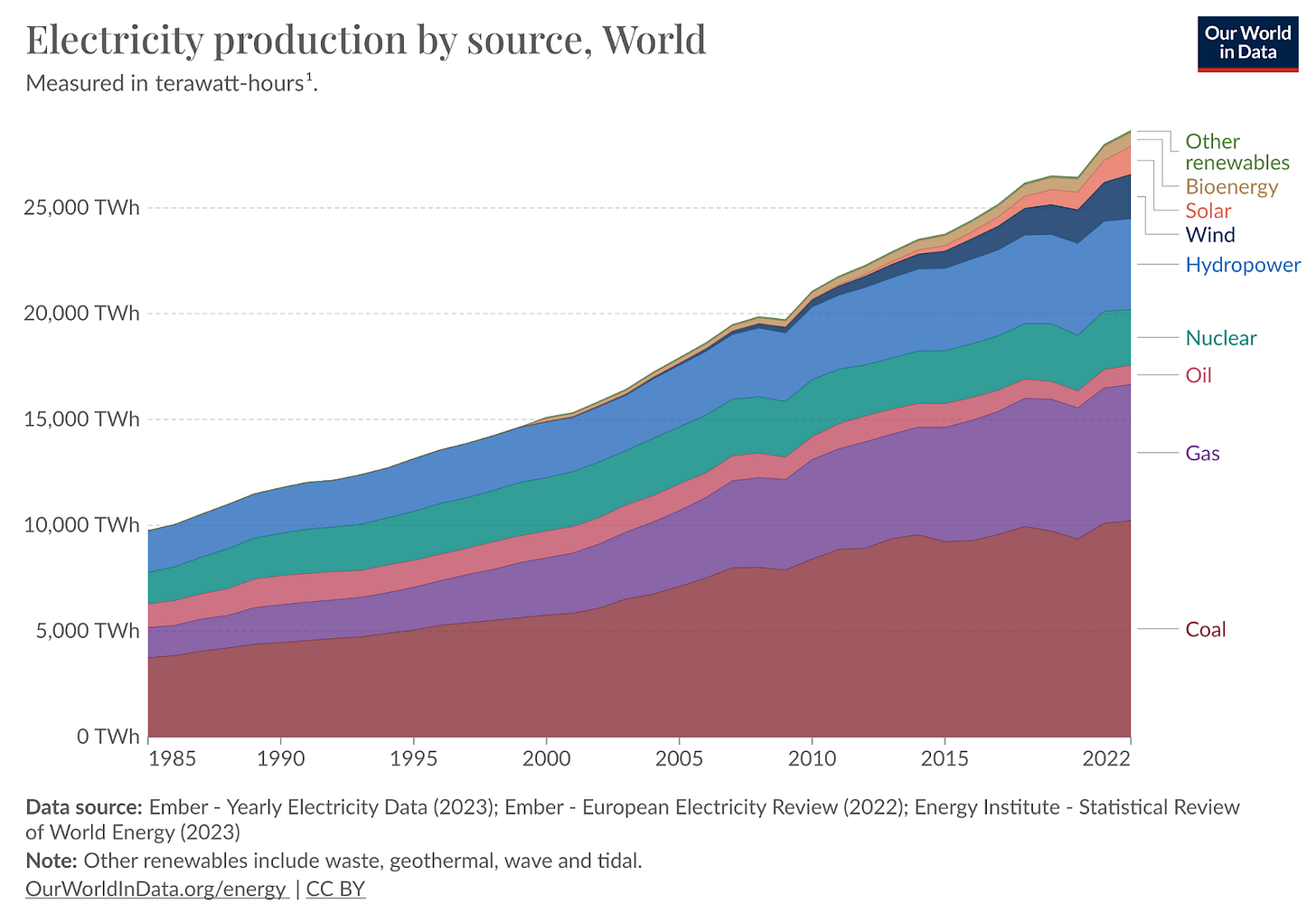Welcome to Earth 1: Our World Today
Before we delve into future energy scenarios, let’s take a moment to look at what the current global energy landscape looks like today and how that has changed in the past 200 years.
Global Energy Production
We’re often taught that humanity used to use certain fuels in the past, but as a society, we have moved on to other, better fuels. The story usually goes like this: Before the Industrial Revolution, we used wood and biomass for fuel and energy. Then, starting around 1760, the Industrial Revolution came about, and we learned how to build new, better machines that were much more efficient and could run on steam from coal. A few decades later, starting around the 1930s, there was a switch to using oil and natural gas instead of coal. Finally, in the past decade, there was a massive increase in renewable energy as it supplants oil and natural gas as the predominant energy source of our era. So how accurate is that story? Let’s take a look.
The figure above shows where we’ve gotten our energy for the past 200 years. What this figure shows is that, in many ways, the narrative that I described above is correct. We did start off with biomass being the main energy source before it was supplanted by coal, oil, and natural gas. Finally you can see a small, but growing fraction coming from wind and solar in the 21st century. Once we plot the total amount of energy consumed every year however, the story gets more complicated:
What immediately jumps out is the massive increase in energy used over the past 200 years. While a particular fuel’s percentage of overall energy might have gone down over time, we have not seen a decrease in our consumption of any energy source. So the amount of biomass used for energy hasn’t decreased appreciably in the past 200 years; we’ve just added new fuels to the mix. The same can be said about coal, oil and natural gas. Additionally, while renewable energy production is increasing, it is still an extremely small percentage of overall energy consumption which is dominated by the big 3 fossil sources of coal, oil, and natural gas.
What this retrospective tells us is that the goal of significantly reducing our dependence on fossil fuels would require us to do something we’ve never done before: massively decrease the amount of energy we get from specific energy sources. That doesn’t mean it is impossible, but it helps contextualize the challenge.
Electricity Generation
One of the main things we do with fuels is convert them to electricity (~40% of total fuel consumption). This electricity is used to do everything from powering our lights to running our air conditioning units. This is encouraging because it is easier for us to decarbonize electricity than it is to decarbonize other energy sources. For example, it is easier for us to produce clean electricity to plug into an electric car than it is for us to generate a chemical fuel that does not produce any carbon dioxide and distribute that fuel around the world to be used in gas stations. For that reason there has been an increased interest in electricity as a powerful tool for decarbonization. So how clean is the electricity we use today?
Well as this plot shows, it’s better than the overall energy mix but it’s still not great. Fossil fuels still account for ~60% of total electricity production and much of the rest comes from hydropower- a wonderful clean electricity source that is unfortunately extremely geographically constrained and limited. So the electricity we use is cleaner than the overall fuels we use but it still has a long way to go.
EV Adoption
Relatedly, there has been a lot of interest in the adoption of electric vehicles around the world. Transportation is a significant energy use (~18% of overall energy goes to transportation) and accounts for ~20% of overall greenhouse gas emissions. For that reason, there has been a focus on moving away from vehicles that burn fossil fuels to their clean counterparts (plug-in hybrids, electric vehicles, hydrogen cars). Encouragingly, there has been a significant rise in the adoption of these vehicles, with ~14% of all cars sold in 2022 being either an electric car or a plug-in hybrid. It is important to note, though, that this is only looking at new car sales. Cars stay around for a long time, and overall, ~97% of all passenger vehicles globally run on fossil fuels.
Conclusion
Hopefully, this brief rundown on the global state of energy wasn’t too disheartening. We can see some green shoots of progress but we still have a long way to go to reach a clean energy future. In the next few posts, we’ll explore different potential scenarios of what that future might look like.







